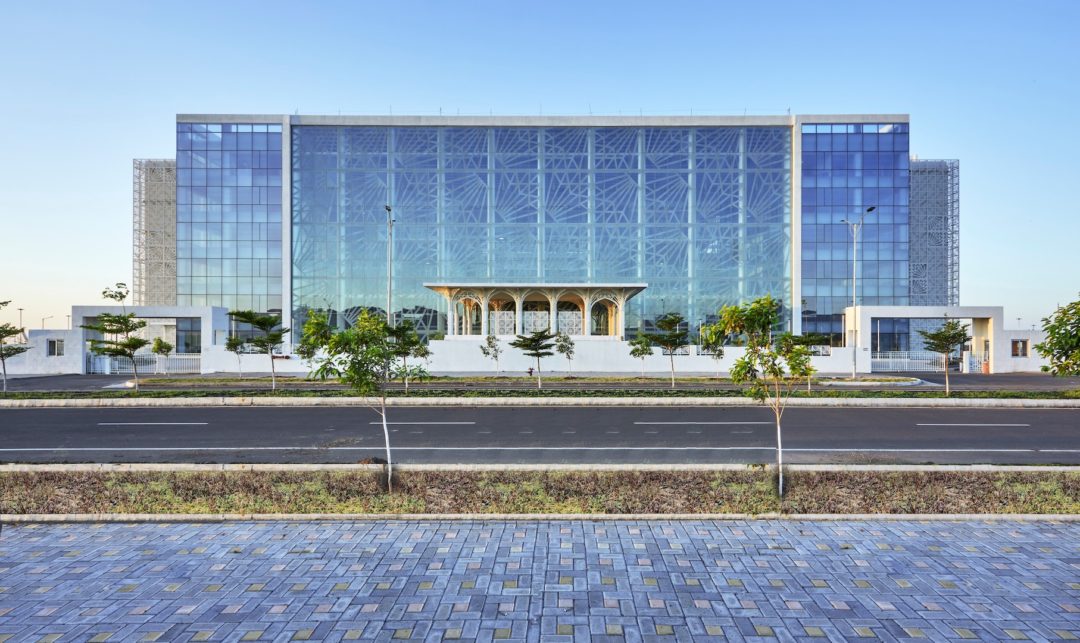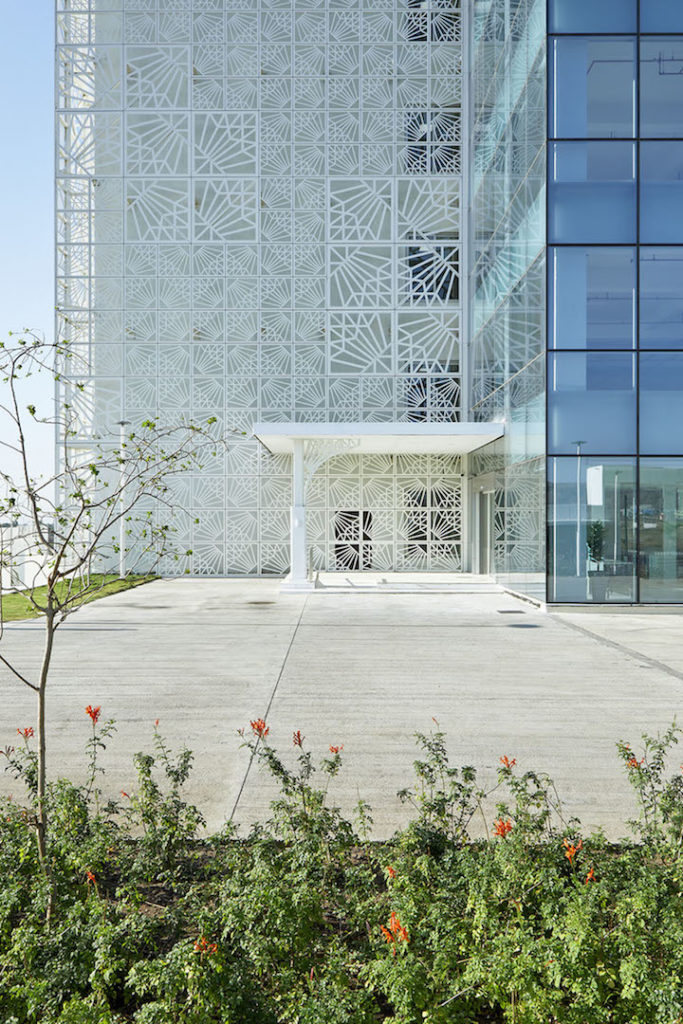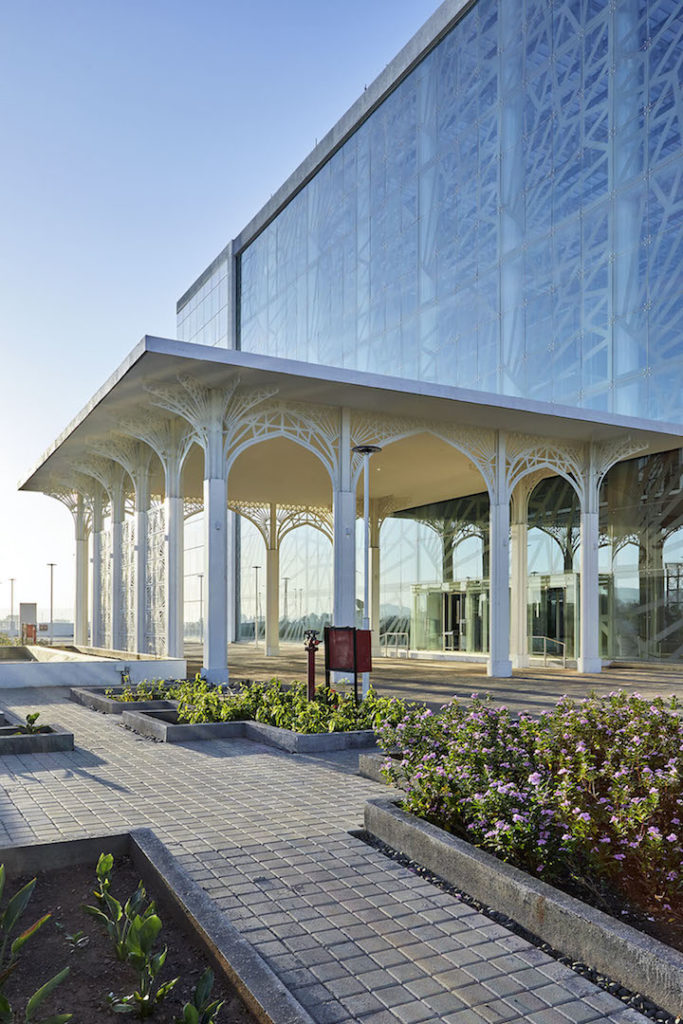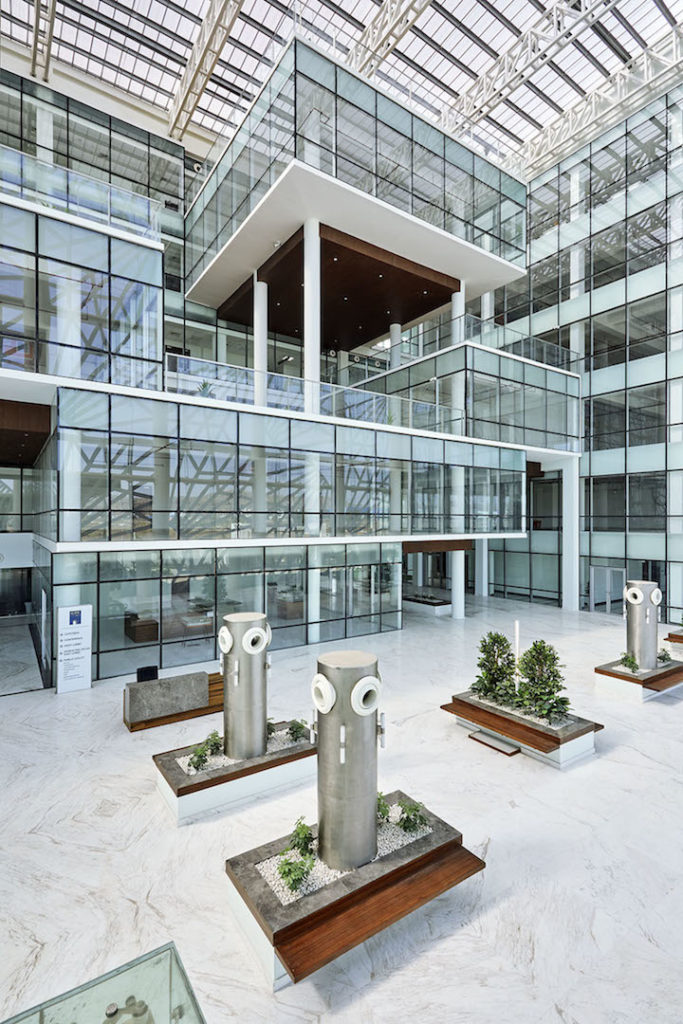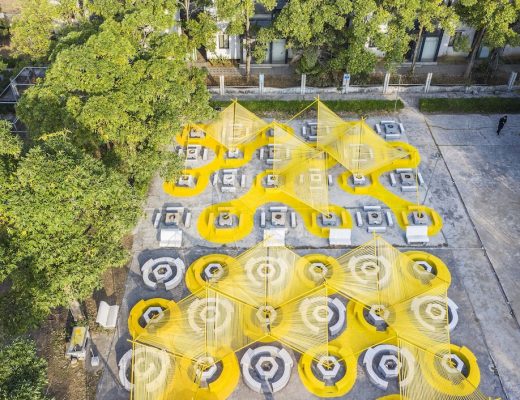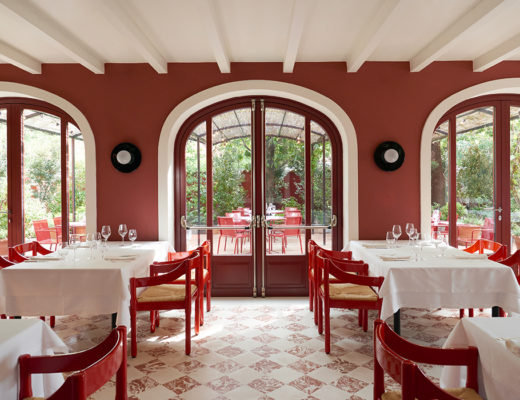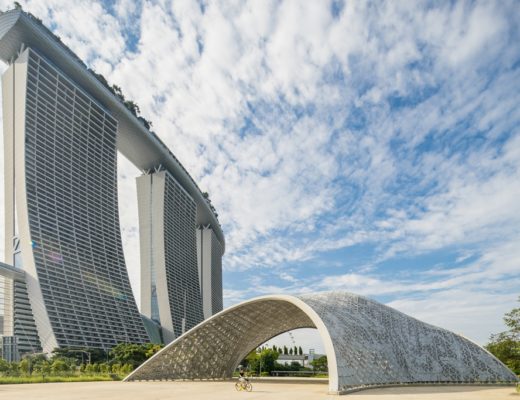Auric Hall by IMK Architects, led by award-winning architect Rahul Kadri, is a district administration building within the Central Business District of Aurangabad, an industrial city in the western Indian province of Maharashtra. The project houses the offices of Aurangabad Industrial City (AURIC), which is part of the larger Delhi-Mumbai Industrial Corridor (DMIC), one of India’s most ambitious infrastructure programmes. Its goal is to develop new industrial cities as ‘Smart Cities’ and converge next-generation technologies across the infrastructure sector. AURIC is one of the Greenfield and Smart industrial cities, being developed as part of DMIC.
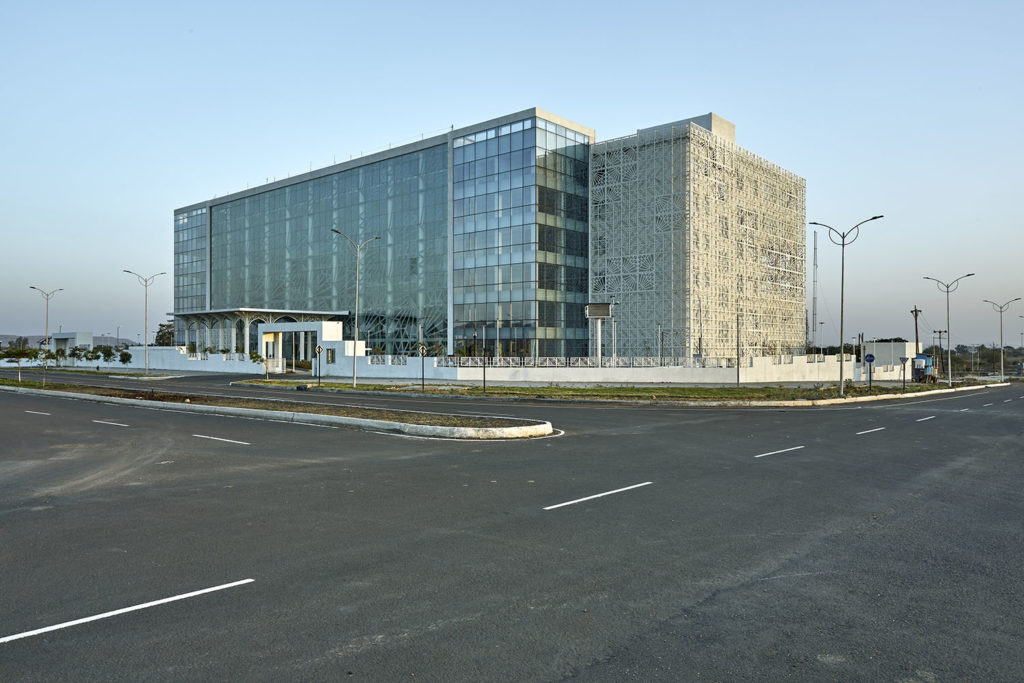
The building, AURIC Hall, has been planned as the face of the upcoming development in the area, complementing the vision of AURIC. The building is both the monitoring and the administrative nerve centre for the smart city, housing the main command control room to manage all the civic utilities on a real-time platform centrally. It offers incubation spaces to the industrial houses setting up at the township and has also been planned to operate as the anchor building that will cater to the needs of staff, visitors, and function as a sales centre.
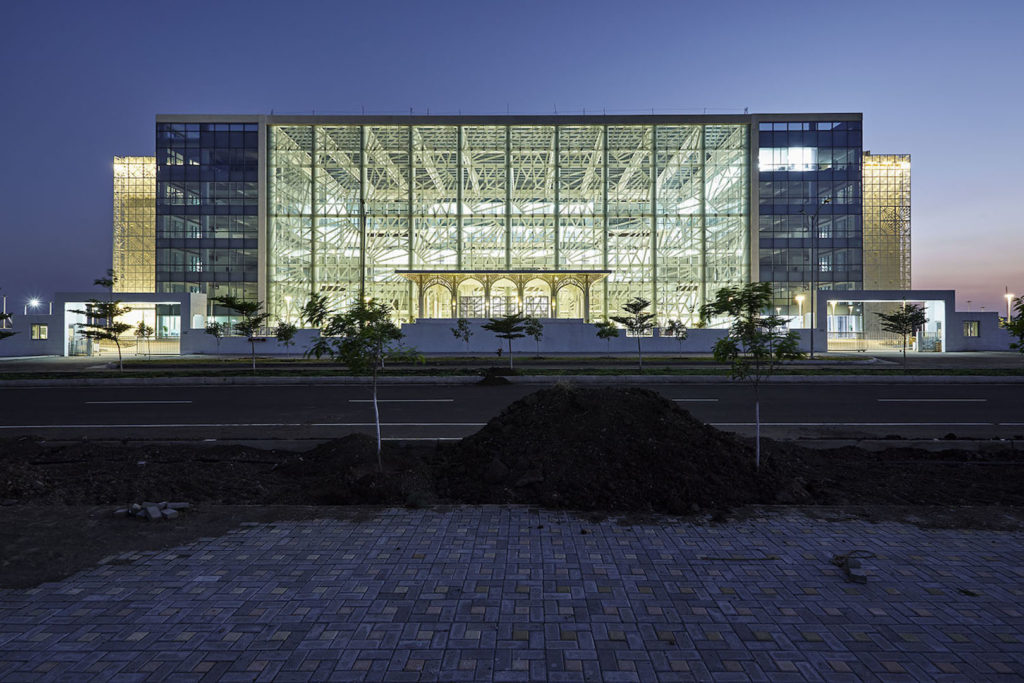
Conceptualised as a building that creates spaces that strive to achieve innovation and transcend expectations. It is a socially responsive building, enhancing engagement with spaces where people and activities thrive, and facilitate interaction of ideas that enable effective solutions.
CLIMATIC CONSIDERATIONS
Although the building features advanced technology and function, it was important that the building is planned with a character that was sensitive to Aurangabad’s climate, context, and rich history. The city features a semiarid climate with extreme temperatures and intense solar radiation coupled with low rainfall. To mitigate these climatic conditions, appropriate form and orientation of the building were considered in the design, in addition to shading methods adopted on the building façade.
HISTORICAL CONTEXT
In imbibing the architectural and historical values from Aurangabad’s Mughal legacy, the tradition of gates as a design element, stands out most in the historical monuments, marking and punctuating various parts of the city. Another aspect is the focus on proportion, repetition, and creation of appealing compositions amid varied massing that integrates with the built volume.
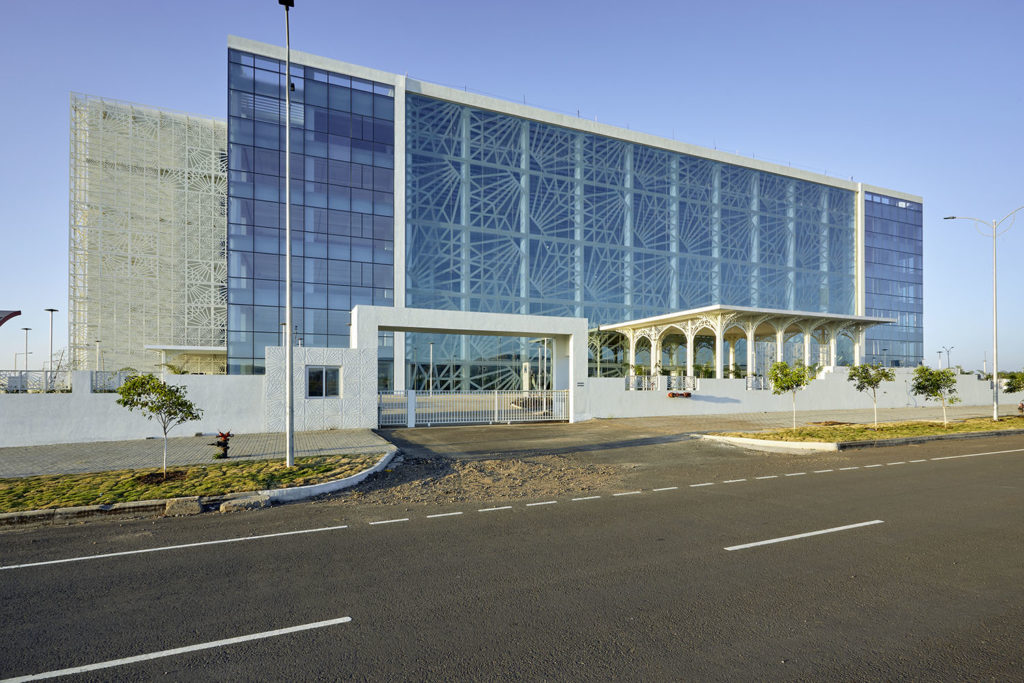
Most of the Mughal building complexes have multiple envelopes creating a sense of enclosure. These are arranged in a series of public, semi-public, and private spaces. The first layer of spaces as you enter are lush green open spaces, nestled between a screen and the main building. The subsequent layer of public spaces are enclosures that create an approach to the beautiful refuge within, with screens that maintain the soft and natural quality of light.
Traditionally, the use of screens protects against the harsh sun. Additionally, the use of jaalis (latticed screens) allows for the control of airflow and helps in lowering down the temperature of internal spaces while letting in diffused natural light. Another traditional feature to be used abundantly is the use of water to control the ambient temperatures.
The layout consists of the large central north-facing atrium, featuring a glass surface to optimise the daylight from the north, with office blocks abutting it on the other three sides, wrapped with an intricate modular jaali (latticed screen). The atrium width, as well as the width of the offices surrounding it, was controlled to ensure maximum daylighting.
The design celebrates the historical glory of old Aurangabad by drawing inspiration from these traditional features and elements found in the city’s rich heritage. The building intends to bring back to life the traditional historical elements through means of modern interpretation, repetition, and symmetry, having played an essential part in the designing and conceptualising of the structure.
ARCHITECTURAL DESIGN
The masterplan for AURIC city had located the administrative building in the CBD within a cluster of buildings around a public green. A natural water body was located to the north of the CBD block, away from the proposed location of AURIC Hall. IMK proposed the rearrangement of the block and relocation of AURIC Hall, such that the water body could add to the value of the spaces within this landmark building.
Ceremonial gateways mark the entrances along the compound wall at the approach to the building, which acts as definite pause points. The landscaping adjoining the internal driveway is inspired by the Char Bagh (Four Gardens) concept along with a cascading water body at its center, creating a focal point at the main entrance to the building. The water body is an inspiration from the Paan Chakki within the heart of the old city. Another series of ceremonious arches mark the entrance to the building at the porch, this time in combination with intricate jaalis (latticed screens), that are reminiscent of the tomb complexes of the old city.
Taking its inspiration from the historic structures like Bibi-ka-Maqbara, patterns have been used in the screens that envelope the building and repeated on the glazed panels as well, echoing the theme of the building. A network of two aluminium screen modules of the same motif but varying scales forms the jaali (latticed screen). This breaks the monotony of the facade while helping control the light and shadow for open terraces and office spaces accordingly.
In contrast to the external symmetry, the interior presents many asymmetric surprises. The porch leads to a large linear and full height atrium space, enclosed by offices on three sides. The atrium was added as a modern interpretation of the garden and related most of the social spaces to face the lake. Every alternate floor has a different layout led by strategically staggered spaces to avoid repetition and homogeneity. The building is a collage of office-spaces and terraces. Simultaneously, along with the atrium, the lift lobby and staircase connect the spaces vertically. Every lift lobby opens onto green double-height terraces that face the south façade on one side and a long connecting corridor on the other.
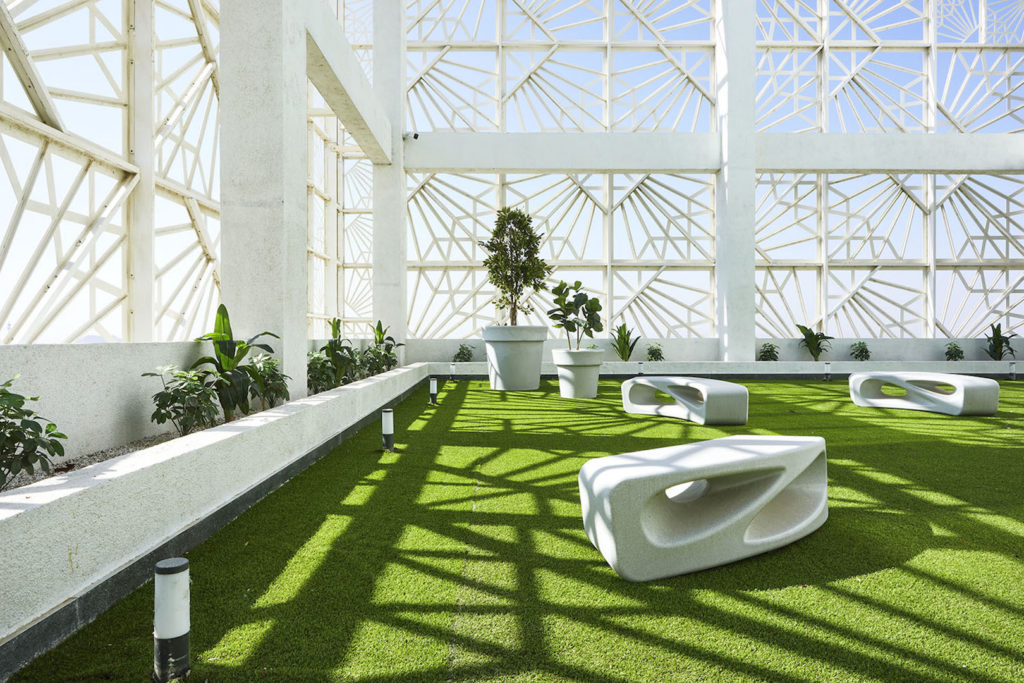
As such, every floor has access to multiple terraces; either outdoor green terraces on the southern edge or indoor-cantilevered terraces that overlook the atrium, encouraging interaction and allowing the users of the building to thrive. These terraces serve as social spaces for the employees and offer a break-out zone from the closed indoors, to foster engagement, collaboration, and cross-pollination of ideas.
Entry-level spaces have been designed to be free-flowing and transparent, to allow visual as well as physical connectivity throughout the ground floor, which houses all the public facilities. The reception block occupies the front of the atrium, along with the control room and visitors center, while the rear is occupied by the public relations teams. The rear blocks are a double-height extension of the atrium, providing free-flowing connectivity at the public level between the AURIC exhibition spaces, the citizen services, the cafeteria, and the toilet blocks.
Aurangabad Industrial Township Ltd (AITL) offices are planned on the topmost floors with adjoining terraces, which serve as viewing galleries for potential buyers.
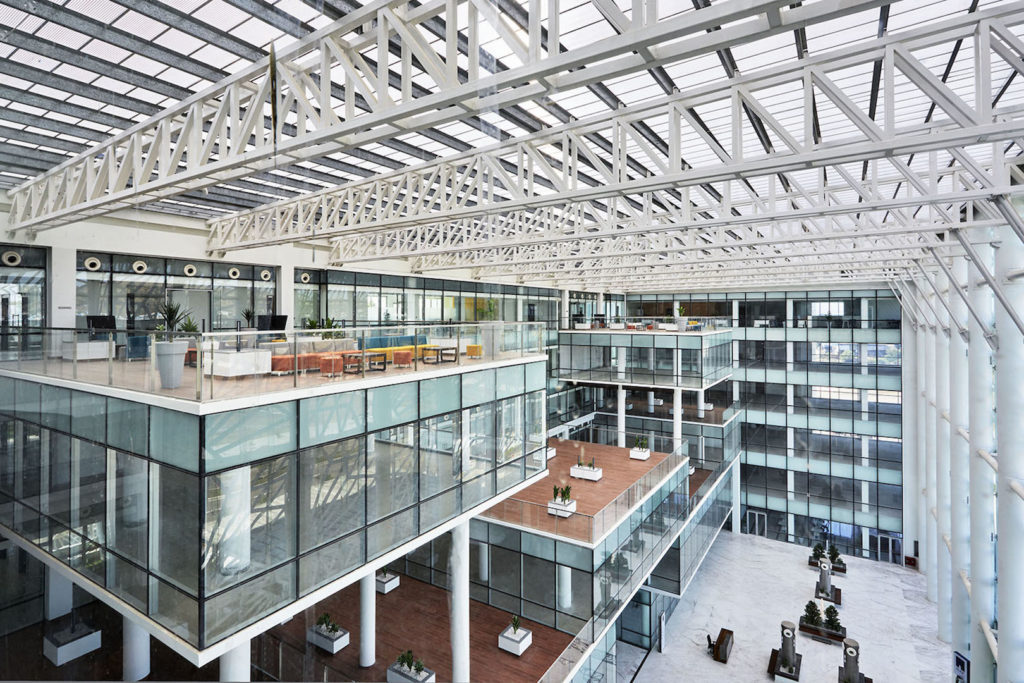
The atrium is intended to serve as an exhibition space, with a display of artwork, to showcase Aurangabad’s rich history. Corridors on all levels overlooking the atrium make it the central display area in the entire building. With the staggered terraces punctuating the atrium volume and north light filtering through the glazed façade, the atrium transforms into a vibrant centre of activity, pulsating with positive energy.
Parking is provided on the surface for VIPs and for other occupants and the public at the lower ground level. The ground adjoining the parking level is at a lower level, which aids in camouflaging the parking spaces as well as the utilities, from the surrounding green spaces. A garden with a large water body lines the entrance approach, that integrates with the water recycling system, being the end of the process of aeration of recycled water.
MATERIALS
In selecting the materials, various factors were taken into consideration, besides the aesthetics of the building.
Commercial and office spaces call for large structural grids to allow for flexibility. As such, post-tension beams were used to enable the large spans and the services height clearances required within a proportionate floor to floor height.
Steel has been used on the façade & roof truss, which are crucial elements of the building. For the larger truss span, steel was a choice due to its durability, structural flexibility, and higher load-carrying capacity. Due to the advantage of steel construction in being rapid, it was a chosen technique to fit within the constrained building completion deadline. Another strength of steel is that it can be constructed off-site and assembled on-site, which saves a lot of time, and multiple works can happen simultaneously.
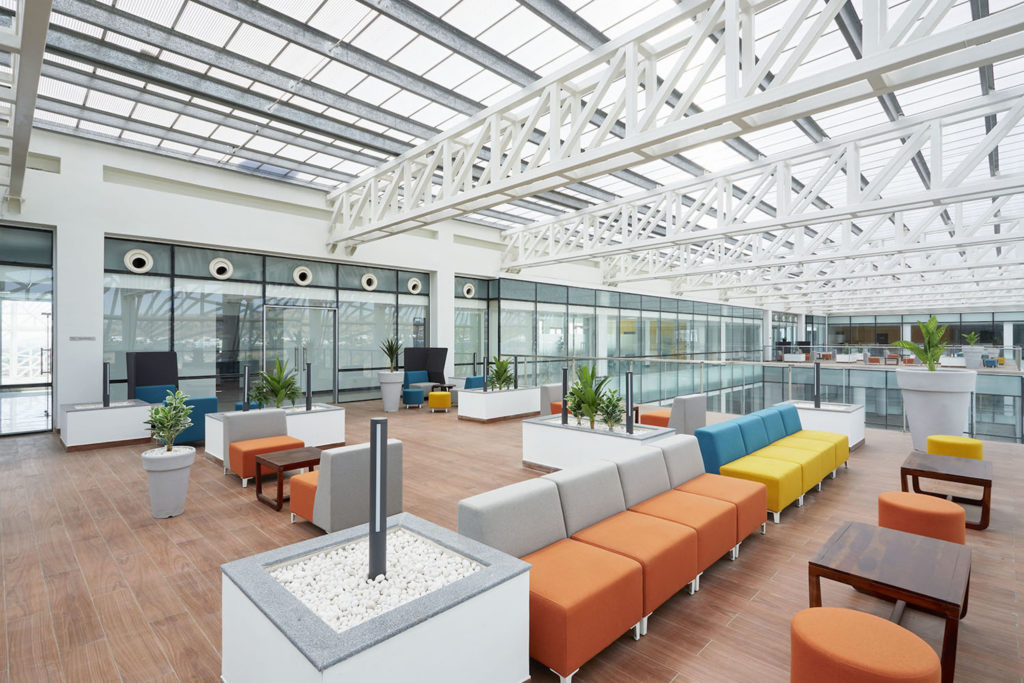
The external lattice screen façade of the building needed to be selected considering various factors — it needed to be lightweight, at the same time robust, incurring low maintenance costs and long-lasting. Laser-cut aluminium panels were finalised in comparison with alternative materials such as concrete, MS, Corten steel, or zinc.
The atrium has been provided with multiwall polycarbonate sheet roofing. This is not only light in weight and hence requires a lighter truss design, but also effectively blocks the glare and minimises the heat gain within the atrium. This, in turn, also helps in reducing the air conditioning cost for the large atrium volume. It is covered with a skylight at the roof level made of polycarbonate sheets that permit glare-free light but block the heat gain.
The large north-facing atrium façade has large glass panels with ceramic fritting. All the offices facing the atrium also have glass walls in line with the open office concept. The glass was carefully chosen again with the required technical specifications making it effective against glare, heat gain, and toughened at the same time against wind pressures and other loads.
SUSTAINABLE DESIGN
AURIC HALL has been designed incorporating climate-responsive and sustainable design practices, embodying low energy costs, and use of high-performance materials to achieve the Indian Gold Building Council Gold Performance rating. The building received plenty of daylight with minimal heat gain. It is a functionally efficient building, well-integrated with natural features and landscape within the site to create an interesting blend of the built form and semi-covered or open spaces while meeting access, parking, and other on-site requirements.
Water conservation measures have been adopted by maximising landscape plantation areas with controlled irrigation measures. Additionally, the runoff from the paved surfaces, as well as the terraces are harvested by allowing for groundwater recharge. The use of efficient plumbing fixtures and installation of wastewater treatment systems further aids the same. The use of solar panels and energy metering and management systems facilitates energy efficiency while CO2 monitoring enables indoor environmental quality control.
Project details
Project name: Auric Hall
Location: Aurangabad
Client: AITL (Aurangabad Industrial Township Limited)
Principal Architect: Mr. Rahul Kadri
Design Team: Anuprita Dixit, Bhumika Ganjawala, Heena Shaikh, Suvidha Mhatre, Tejashree Rajeshirke
IMK Business development Architect- Preeti Valanju
IMK Engineer – Harish Vyas
Site Area (sq ft & sq m): 154172 sq.ft & 14323.04 Sq.mt
Built-Up Area (sq ft & sq m): 179334 sq.ft & 16660.67 sq.m.
Start Date: October 2017
Completion Date: April 2019
Photographer: Rajesh Vora
You might also like:
What do India’s Covid-19 affected cities need? The country’s leading architects propose solutions
Sanjay Puri Architects designs eco-friendly hotel with stacked balconies in India’s wine region
Zaha Hadid Architects reveals renders of the new international airport in India’s Mumbai city

